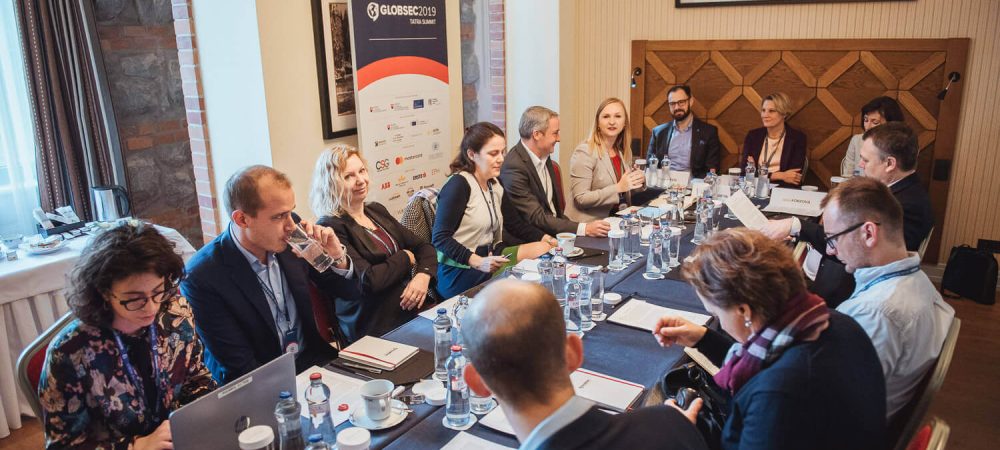Despite some progress, public and private sector still do not reflect the gender diversity of the population represented. We realise the need to discuss these issues at our platforms, therefore last year’s GLOBSEC Tatra Summit staged a Focus Group that discussed the topic and offered practical recommendations as well. The discussion was led by Alexandra Martin, Strategic Forums Director, GLOBSEC and included the kick-off speakers: Tanja Vainio, Country Managing Director Czech Republic and Slovakia, ABB; Jana Kobzová, Chief Foreign Policy Expert, Office of the President of the Slovak Republic and Dávid Andor, Executive Director, Visegrad Fund.
While gender diversity at a workplace is associated with multiple benefits, we can observe lack of gender diversity at different dimensions horizontally by the absence of female professionals in several sectors, as well as vertically by the scarcity of senior female professionals. What is behind this gender gap.
Although a little progress has been achieved in the public sector diversity, there is a significant lack of women in political assemblies and governments in the EU. Gender diversity in decision-making institutions is yet crucial as they influence the distribution of goods and services in society. Gender diversity decreases the risk of groupthink, facilitates more informed and inclusive policymaking, contributes to inclusive and sustainable growth and even enhances the confidence in government.
Barriers to gender diversity in political decision-making and top public sector positions are similar to those in the private sector. They include material factors such as unequal access to key resources, working conditions and unequal family responsibilities, but also social stereotypes such as male-dominated political cultures, association of leadership and managerial roles with men, absence of female role models and women’s self-perception or low leadership aspirations.
Improvement in private sector is faster than in public sector, but there is still a lot to do. While fast progress has been achieved in the EU corporates, areas of improvement remain in sectoral and size perspectives. Consumer or healthcare segments have an equal proportion of women on board, while IT and industrial sectors lag. Gender diversity improves financial performance as a result of a strong talent pipeline, balanced mix of skills and increased innovation. Diverse teams have better mix of skills, higher collective intelligence and lower risk-seeking attitude. Diverse leadership positions improve governance and capital allocation. Better innovativeness is evident in consumer products, but also in R&D where gender diverse teams have higher chances for radical innovation, are more likely to report market share growth and more likely capturing a new segment. However, social bias and double burden of family roles are frequent obstacles for senior position recruitment and promotion.
So how can we remove these barriers and move towards a more diverse work environment as well as society? We came up with the following recommendations and measures to be considered:
- Access to quality education should encourage self-realisation, dismantling gender stereotypes, and encouraging women to pursue studies in sectors where they are under-represented. Programme initiatives, female role models, vocational education and retraining should ensure that population, including women, have access to skills in demand.
- Access to quality employment should include measures to facilitate women’s participation in the labour market in general such as maternity leave policies, fiscal measures and working arrangements to support families with two working parents, better social care infrastructure and better designed, gender-responsive infrastructure. It should also include measures to facilitate women’s access to managerial positions such as mentoring and advice programmes. Role models, discussions and training on constraining conditions, gender discrimination patterns, unconscious biases, unbiased HR processes, quotas, diversity transparency reporting combined with voluntary targets, business cases/evidence-driven arguments on links between gender diversity and business performance are equally important.
- Access to financial resources can include financing programmes to increase women’s access to financing e.g. credit lines targeting SMEs with women in decision-making positions, or programmes targeting sectors in which women are more likely to be active, social impact programmes, advisory and business development services for female entrepreneurs.
- Access to decision-making can be obtained through quotas for political parties’ candidate lists, zipper presentation of candidates alternating men and women, equal access to and representation of women and men candidates, transparency requirements for public sector gender diversity at all levels, requirements for gender-responsive budgeting and analysis of gender-related effects in all aspects of policy-making.
We would like to thank all the participants of this Focus Group for a very constructive and inspiring debate. As was agreed, in order to achieve an equal representation of men and women in the workplace, we must accept that it takes time and keep working on it. But the more we talk about change, the more likely it is to happen. So, let’s create this positive change together!

